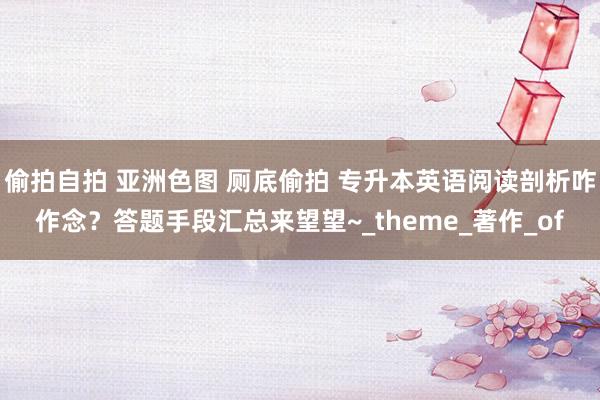
英语是专升本西宾的必考科目,邻近西宾偷拍自拍 亚洲色图 厕底偷拍,很多同学说阅读剖析一错错一半,找不到临时“能报的佛脚“。短时分怎样把分数提上去?
综合来看,“阅读剖析”是最佳提分的一个题型。“阅读剖析”是英语西宾中的必考题型,亦然丢分最多的题型。
可能会有同学说,一篇阅读五个选项,我能对 2 个就可以了,基本都是连蒙带猜,怎样提升正确率??
准备插足专升本西宾的同学看过来啦,今天小编给群众带来了“阅读剖析”的驻扎答题手段,期待群众用起来,西宾少丢分、多得分!
阅读剖析丢分原因
①单词量不够,无法剖析著作的一皆本色。
②答题无章法、无手段,酿成前边耗时过多,背面为了追速率,草草阅读,出错率高。
阅读剖析答题手段
伸开剩余92%主旨粗疏题
这类题在设题深广会用到 title, subject, main idea, topic, theme等词。
勾引twitter0
1
归纳标题
本性:大而无当,一般多为一个短语;涵盖性强,一般能遮蔽全文敬爱;精准性强,抒发规模要顺应,不可粗拙篡改语意进程或颜色。常见命题口头有:
1.What’s the best title for the text?
2.The best title for this passage is ___.
3.Which of the following can be the best title for the passage?
0
2
综合粗疏题
包括寻找段落粗疏(topic)和著作中心念念想(main idea),常见命题口头有:
1.What is the general/main idea of the passage?
2.Which of the following expresses the main idea?
3.What is the subject discussed in the text?
4.The writer of the story wants to tell us that_____.
5.The passage/ text is mainly about_____.
6.What’s the article mainly about ?
0
3
解题手段
阅读剖析著作多是论说文和确认文,这两种体裁的结构可归纳为:建议问题——评释问题——得出论断或者发达不雅点。
关于这类著作,抓主题句是快速掌持著作粗疏的主要圭臬。主题句一般出当今著作的起原或收尾。主题句具有松弛性、综合性的本性。
细节剖析题
检会本色主要波实时分、地点、东谈主物、事件、原因、罢休、数字等论说文中例证细节和界说类细节。这类题场合共同本性是:谜底一般都能在著作中找到。
0
1
事实细节题→寻读法
分为胜利剖析题和迤逦剖析题,前者常用who, what, which, when, where, why和how发问,或判断正误;后者需与原文信息休养,抒发上与原文有相反。常见命题口头有:
1.What can we learn from the passage?
2.All the following are mentioned except?
3.Which of the following is mentioned (not mentioned)?
4.Which of the following statements is true/right/false/wrong about…?
0
2
罗列端正题→首尾定位法
(找出第一个事件和终末一个事件偷拍自拍 亚洲色图 厕底偷拍,用摒除法收缩规模)
常出当今记述文和确认文中,一般按事件发生的端正。常见命题口头有:
1.Which of the following is the correct order of…?
2.Which of the following shows the path of signals described in Paragraph…?
03
图文匹配题→胶柱调瑟理清踪影
设题口头:给出图表,证据图表发问问题。
0
4
数字野心题→
(圭臬:审题→带着问题找细节→对比、分析、野心)
可胜利找到关联细节,但需经过野心方可找到谜底。
推理判断题
主要检会学生对著作中隐含或深层的含意的剖析才能。它条件考生证据著作本色作念出符合逻辑的推断,包括考生对作家不雅点的剖析,魄力的判断,对修辞、口吻、隐含敬爱等的剖析。
题干要津词:infer(推断),indicate(象征,示意), imply/suggest(示意), conclude(作出论断), assume(假设,
设想)。
0
1
细节推理判断题
一般可证据随笔提供的信息或借助糊口学问进行推理判断,常见命题口头有:
1.It can be inferred/ concluded from the text that __________.
2.The author implies/ suggests that_____.
3.We may infer that _________.
4.Which of the following statements is implied but NOT stated?
0
2
研究推理判断题
证据语篇对著作接下来的本色或可能的结局进行揣测,常见命题口头有:
1.What do you think will happen if/when…?
2.At the end of this passage, the writer might continue to write_____
0
3
推测著作来源或读者对象
常见命题口头有:
1.The passage is probably take out of_____
2.The passage would most likely be found in_____
3.Where does this text probably come from?
0
4
写稿意图、场合、魄力推断题
斟酌写稿场合的题,选项里常出现的词是:explain(解释), prove (评释), persuade(劝说), advise(劝告), comment(驳斥), praise(传诵), criticize(品评), entertain(文娱), demonstrate(例如确认), argue(辩说), tell(讲述), analyze(分析)等。
斟酌口吻魄力的题,选项里常出现的词是:
neutral(中立的), sympathetic(惋惜的), satisfied(平定的), friendly(友好的), enthusiastic(关心的), subjective(主不雅的), objective(客不雅的), matter-of-fact(本天职分的), pessimistic(悲不雅的), optimistic(乐不雅的), critical(品评的), doubtful(怀疑的), hostile(烦恼的),indifferent(冷淡的), disappointed(失望的)。
常见命题口头有:
1.The purpose of the text is_____
2.What is the main purpose of the author writing the text? By mentioning…, the author aims to show that_____
3.What is the author’s attitude towards…?
4.What is the author’s opinion on…?
5.The author’s tone in this passage is _____.
0
5
解答手段
推断题是检会学生透过著作名义的翰墨信息进行分析、综合、归纳等逻辑推理的才能。推理和判断必须以事实为依据,切莫主不雅臆断。
①那些著作中胜利陈诉的本色不可选,要采选证据著作推理出来的选项。
②推理不是捏造揣测,而是驻足已知推断未知;作出正确谜底时一定要在文中找到依据或情理。
③要古道于原文,以著作提供的事实和踪影为依据。不可以我方的不雅点代替作家的概念;不要脱离原文主不雅臆断。
词义揣测题
考点:
①揣测某个词、词组、句子的真谛
②对文中的多义词或词组进行界说
③判断某个代词的指代的对象。常见命题口头有:
1.The underlined word/phrase in the second paragraph means _____.
2.The word “it/they” in the last sentence refers to______.
3.The word “…”(Line 6. para.2)probably means ______.
4.The word “…”(Line 6. para.2)could best be replaced by which of the following?
5.Which of the following is closest in meaning to the word “…”?
解答手段:
0
1
通过因果干系猜词
最初是找出身词与落魄文之间的逻辑干系,然后才能猜词。巧合著作借助但是(如because,as,since,for,so,thus,as a result,of course等等)涌现前因效力。
例如:You shouldn't have blamed him for that,for it wasn't his fault.通过for引出的句子所涌现的原因(那不是他的错),可猜出blame的词义是"非难"。
02
通过同义词和反义词的干系猜词
通过同义词猜词,一是要看由and或or流畅的同义词词组,如happy and gay,即使咱们不虞识gay这个词,也可以知谈它是兴奋的敬爱;
二是看在进一步解释的历程中使用的同义词,如Man has known something about the planets Venus,Mars,and Jupiter with the help of spaceships.此句中的Venus(金星)、Mars(火星)、Jupiter(木星)均为生词,但唯有知谈planets就可猜出这几个词都属于"行星"这一义域。
通过反义词猜词,一是看表滚动干系的连词或副词,如but,while,however等;
三是看与not搭配的或涌现含糊真谛的词语,如:He is so homely,not at all as handsome as his brother.证据not at all...handsome咱们不难推测出homely的敬爱,即不超脱、不漂亮的敬爱。
0
3
通过构词法猜词
证据前缀、后缀、复合、派生等构词知识判断生词词义。如:She is unlikely to have stolen the money. ( “un”含含糊真谛,故为“不太可能”之意。)
0
4
通过界说或释义干系来推测词义
例如:But sometimes,no rain falls for a long,long time. Then there is a dry period,or drought. 从drought所在句子的上文咱们得知很久不下雨,于是便有一段干旱的技能,即drought,由此可见drought敬爱为"亢旱","旱灾"。而a dry period和drought是同义语。
这种同义或释义干系常由is,or,that is,in other words,be called或破折号等来涌现。
0
5
通过句法功能来推测词义
例如:
Bananas,oranges,pineapples,coconuts and some other kind of fruit grow in warm areas.假如pineapples和coconuts是生词,咱们可以从这两个词在句中所处的位置来判断它们大略的敬爱。
从句中不出丑出pineapples,coconuts和bananas偷拍自拍 亚洲色图 厕底偷拍,oranges是同类干系,同属fruit类,因此它们是两样生果,准确地说,是菠萝和椰子。
发布于:陕西省